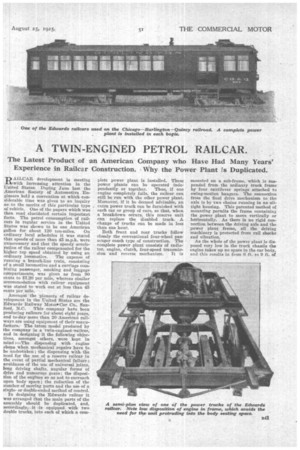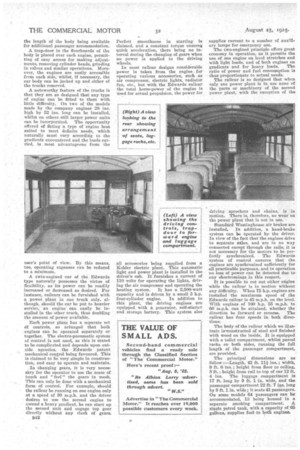A TWIN-ENGINED PETROL RAILCAR.
Page 23

Page 24

If you've noticed an error in this article please click here to report it so we can fix it.
The Latest Product of an American Company who Have Had Many Years' Experience in Railcar Construction. Why the Power Plant is Duplicated.
RAILCAR development is meeting with increasing attention in the United States. Daring June last the American Society of Automotive Engineers held a convention at which considerable time was given to an inquiry as. to the merits of this particular type of vehicle. One of the papers which was then read elucidated certain important facts. The petrol consumption of railcars in regular service in the United States was shown to be one American
gallon for about 120 ton-miles. On crdinary local schedules it was stated that speeds of more than 45 m.p.h. were unnecessary and that the speedy acceleration of the railcar compensated for the higher top speed obtained by using an ordinary l000rnotive. The expense of running a branch-line train, consisting of a small locomotive and a carriage combining passenger, smoking and luggage compartments, was given as from 90 cents to $1.20 per mile, whereas similar accommodation with railcar equipment was stated to work out at less than 45 cents per mile.
Amongst the pioneers of railcar development in the United States are the Edwards Railway MotorrCar Co., Sanford, N.C. This company hate been producing railcars for about eight years, and to-day more than 20 American railways arc using equipment of their manufacture. The latest model produced by the company is a twin-engined•railcar, and in designing it the following objectives, amongst others, were kept in mind :—The dispensing with engine shops when mechanical repairs have to be undertaken ; the dispensing with the need for the use of a reserve railcar in the event of partial mechanical faihire ; avoidance of the use of universal joints, long driving shafts, angular forms of drive and numerous gears; the disposition of the engines so as not to encroach upon body space; the reduction of the munber of moving parts and the use of a singleor double-ended method of control.
In designing the Edwards railcar it Was arranged that the main parts of the assembly should be dnplicate.d, and, accordingly, it is equipped with two double trucks, into each of which a corn
plete power plant is installed. These power plants can be operated inde
pendently or together. Thus, if one engine completely fails, the railcar can still be rub with the other power plant. Moreover, if it be deemed advisable, an extra power truck can be furnished with each car or group of cars, so that, when a breakdown occurs, this reserve unit can replace the disabled truck. A change of trucks can be made in less than one hoof.
Both front and rear trucks follow closely the conventional four-wheel passenger coach type of construction. The complete power plant consists of radiator, engine, clutch, four-speed transmission and reverse mechanism. It is mounted on a sub-frame, which is suspended from the ordinary truck frame by four cantilever springs attached to swing-motion hangers. The connection from the final drive mechanism to the axle is by two chains running in an oiltight housing. This patented method of mounting permits the frame containing the power plant to move vertically or horizontally. As there is no rigid connection between the driving axle and the Power plant frame, all the driving machinery is protected from rail shocks and vibration.
As the whole of the power plant is disposed very low in the truck chassis the engine takes up no space in the car body, and this results in from 6 ft. to 9 ft. of the length of the body being available for additional passenger accommodation.
A trap-door in the floorboards of the body is placed over each engine, permitting of easy access for making adjustments, removing cylinder heads, grinding in valves and similar operations. Moreover, the engines are easily accessible from each side, whilst, if necessary, the ear body can be jacked up and either of the trucks removed.
A noteworthy feature of the trucks is that they are so designed that any type of engine can be fitted to them with little difficulty. On two of the models made by the company engines 28 ins. high by 52 ins, long can be installed, whilst on others still larger power units can be incorporated. The opportunity offered of fitting a type of engine best suited to meet definite needs, which naturally must vary according to the gradients encountered and the loads carried, is . most advantageous from the user's point of view. By this means, too, operating expenses can be reduced to a minimum.
A twin-engined car of the Edwards type naturally possesses the virtue of flexibility, as its power can be readily increased or decreased as desired. For instance, railoars can be furnished with a power, plant in one truck, only, although, should the car be put to heavier service, an engine can easily be installed in the other truck, thuS doubling the amount of power available.
Each power plant has a separate set if controls, so arianged that both engines can be operated separately or together. The electro-pneumatic system. of control is not used, as this is stated to be complicated and depends upon outside agencies, the Edwards patent mechanical control being favoured. This is claimed to be very simple in construction, and easy to operate and maintain.
, In Changing gears, it is very necessary for the operator to use the sense of touch and "feel" the gears in mesh. This can only be done with a mechanical form of control. For example, should the railcar be running on one engine only at a speed of 30 m.p.h. and the driver desires to use the second engine to ascend a heavy gradient, he can start up the second unit and engage top gear directly without any clash of gears.
B42 Perfect smoothness in starting is claimed, and a constant torque ensures quick acceleration, there being no interval during the changing of gears when no power is applied to the driving wheels.
In most railcar designs considerable power is taken from the engine for operating various accessories, such as air compressor, electric lights, radiator fan, etc., but with the Edwards railcar the total horse-power of the engine is used for actual propulsion, the power for
ali accessories being supplied from a Kohler electric plant. This automatic light and power plant is installed in the driver's cab. It furnishes a current of 110 volts for operating the lights, driving the air compresses and operating the heating system. It has a 2,500-watt capacity and is driven by a small 3 h.p.
four-cylinder engine. In addition to this plant, the driving engines are equipped with a generator, self-starter and storage battery. This system also supplies current to a number of auxiliary lamps for emergency use.
The two-engined principle offers great economy in operation, as it permits the use of one engine on level stretches and with light loads, and of both engines on gradients and for heavy loads. The ratio of power and fuel consumption is thus proportionate to actual needs. The railcar is so designed that when only one power plant is in use none of the Parts or machinery of the second power plant, with the exception of the driving sprockets and chains, is in motion. There is, therefore, no wear on the power plant that is not in use. •
Standard Westinghouse air brakes are installed. In addition, a hand-brake system can be Operated by the driver. In view of the fact that the engines drive to separate aXies, and are in PO way
• connected except through the rails, it is not necessary for the motor's to be perfectly synchronised. The Edwarda system of sontrol ensures that the engines are synchronized sufficiently for all practicable purposes, and in operation no loss of power can be detected due to any shortcomings in this respect.
It is possible to Cut out either engine while the railcar is in motion without any difficulty. When 75 h.p. engines are installed the maximum speed of the Edwards railcar is 45 m.p.h. on the level. With engines of 100 h.p. 55 m.p.h. to 60 m.p.h. can be attained, whether the direction be forward or reverse. The railcar has four speeds in both directions.
The body of the railcar which we illustrate is constructed of steel and finished with wood on the inside. It is equipped with a toilet compartment, whilst parcel racks on both sides, running the full length of the passenger compartment, are provided.
The principal dimensions are as
follow :—Length, 42 ft. 11i ; width, 9 ft. 6 ins.; height from floor to ceiling. Sit.; height from rail to top of car 12 ft. 4 ins. The luggage compartment is 17 ft. long by 9 ft. 1 in, wide, and the passenger compartment 22 ft. 7 ins, long by 9 ft. 1 in. wide ; it seats 41 passengers. On some models 64 passengers can be` accommodated, 13 being housed in a separate smoking compartment. A single petrol tank, with a capacity of, 65 gallons, supplies fuel to both engines.




























